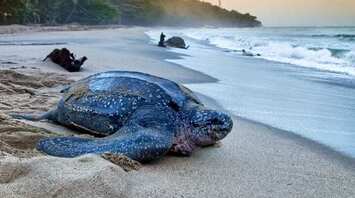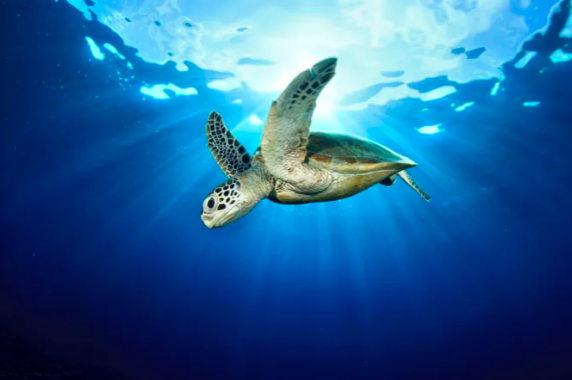20 facts about sea turtles you didn't know

Sea turtles live in waters all over the world (except in the far north and south of the planet) and can live up to 80 years. There are seven species of sea turtles, and six of them - the green turtle, hawksbill turtle, Kemp's ridley turtle, leatherback turtle, loggerhead turtle, and olive ridley turtle - are endangered.
Here are 20 more things you might not know about sea turtles, according to Mentalfloss.com.

Hawksbill sea turtles are named for their jaws
Hawksbill sea turtles (Eretmochelys imbricata) have raptor-like jaws to reach hard-to-reach places in coral reefs. Their favorite food is sponges.
Green sea turtles eat greens
Green turtles (Chelonia mydas), the only herbivorous sea turtles, eat a vegetarian diet of seagrass and algae. This is how they get their greenish color.
Leatherback sea turtles are adapted to eat soft creatures
Leatherbacks (Dermochelys coriacea) eat jellyfish and other soft-bodied animals and have hard spines in their throats that help them swallow this slippery prey.
Olive ridley turtles nest en masse
Olive ridley turtles (Lepidochelys olivacea) practice nesting in large groups known as arribadas ("arrivals" in Spanish). This spectacular event is observed in only five: Mexico, Nicaragua, Costa Rica, Panama and India. Arribadas can include up to 200,000 individuals.
Nest temperature determines the sex of sea turtle hatchlings
Higher temperatures mean more females and lower temperatures mean more males. In a 2014 study published in the journal Nature that examined sea turtle rookeries in Cape Verde, scientists estimated that "light [cooler] beaches now have 70.10% females, while dark [warmer] beaches have 93.46% females.
Home movies helped solve the mystery of tern nesting
For decades, scientists had no idea where Kemp's ridley sea turtles (Lepidochelys kempii) nested. Then, in 1961, at a meeting of the American Society of Ichthyologists and Herpetologists in Austin, Texas, biologists saw a home movie made in 1947 by Andres Herrera, an athlete and naturalist. It shows at least 40,000 Kemp's ridley turtles nesting on a beach on the northern Gulf Coast.
Kemp's ridley turtles now live in Texas
To increase their population, an auxiliary nesting site for Kemp's ridley sea turtles was created on the Padre Island National Seashore in Texas. Biologists collected more than 20,000 eggs that had been laid at the Mexican site, transferred them to Texas, where they were incubated and hatched; and released the hatchlings onto the sandy beaches of Padre Island. In 1996, officials released 369 hatchlings; by 2013, that number had grown to 11,369.
Kemp's ridley turtles have been affected by the Deepwater Horizon oil spill
Studies have shown that the number of Kemp's ridley turtles at the site of the Deepwater Horizon oil spill in the Gulf of Mexico in 2010 was significantly higher than previously thought, and some scientists are concerned that the Texas nesting population will continue to suffer as a result.
One threat to sea turtles almost eliminated
Sea turtle mortality in shrimp trawls (called bycatch) was once a serious problem in the Gulf of Mexico, but the introduction of turtle exclusion devices (TEDs) on trawl nets in the 1980s dramatically reduced the number of sea turtles killed.
Light can also prevent bycatch of sea turtles
Small-scale coastal gillnet fisheries, common in many countries, accidentally catch significant numbers of sea turtles by injuring or drowning them. But changing the type of bait or using ultraviolet (UV) LEDs could reduce the likelihood of capture, according to a 2013 study in the journal Biology Letters.
Sea turtles can dive deep and stay underwater for long periods of time
As reptiles, sea turtles breathe air, but they have the ability to stay underwater for hours. Leatherback sea turtles can dive to depths of up to 3000 feet.
Sea turtles are long-distance swimmers
Sea turtles have been documented to migrate long distances. One was tracked traveling over 9000 miles from Baja California to Japan.
Dog trained to sniff out hidden sea turtle nests
While most species of sea turtles nest at night, the Kemp's ridley turtle nests during the day, when the wind quickly sweeps away the tracks of the females. This can make it difficult for Padre Island National Seashore staff to find nests so they can bring eggs to a special lab for incubation. Dr. Donna Shaver, a supervisory wildlife biologist at the coast, trained her Cairn Terrier, Ridley, to sniff out nests. Since then, other dogs have been trained to find sea turtle nests in other locations.
Scientists use nail tools to track sea turtle hatchlings
Scientists know little about the early stages of sea turtle life. Due to the small size and rapid growth of hatchlings, conventional methods of attaching tracking tags do not work. But the researchers found that a neoprene-silicone nozzle on an acrylic base coat - just like the kind used for false nails - kept the tags on for an average of 70 days, long enough to clear up many of the mysteries of those lost years
Scientists carry out mass evacuation of sea turtle eggs
After the Deepwater Horizon oil spill, scientists were concerned that sea turtles hatching on the beaches of the Gulf of Alabama and northern Florida would swim out into the deadly oil. They began a massive relocation effort, moving 28,000 eggs between June 25 and August 18 of that year to the Kennedy Space Center on Florida's east coast. (The eggs were shipped by FedEx.)
Sea turtles are still threatened by poaching
Poaching remains a significant threat to sea turtles worldwide.
Sea turtles get tumors
Fibropapillomatosis is a chronic and often fatal disease of sea turtles that causes tumors to form.
Sea turtles eat a lot of plastic
Plastic debris in the ocean poses a significant threat to sea turtles. A 2013 study found that leatherback and green sea turtles are at the highest risk of getting sick or dying from plastic consumption.
Volunteers help save sea turtles
Sea turtle conservation projects around the world rely on volunteers to help patrol nesting beaches, move eggs to protected pens, and monitor hatchlings.
Sea turtles use the Earth's magnetic field to navigate
A female sea turtle returns to the beach where she hatched when it is time to lay her own eggs.



















